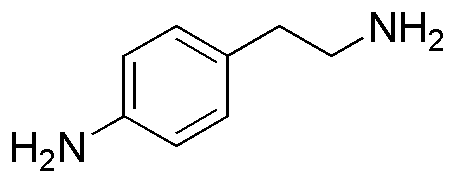2-(4-Aminophenyl)ethylamine is widely utilized in research focused on:
- Pharmaceutical Development: This compound serves as a key intermediate in the synthesis of various pharmaceuticals, particularly in the development of drugs targeting neurological disorders.
- Biochemical Research: It is used in studies related to neurotransmitter systems, helping researchers understand the role of amines in brain function and behavior.
- Polymer Chemistry: The compound is incorporated into polymer formulations to enhance properties such as thermal stability and mechanical strength, making it valuable in materials science.
- Diagnostic Reagents: It acts as a precursor in the production of diagnostic agents, aiding in the development of tests for various medical conditions.
- Environmental Applications: Researchers utilize it in the study of pollutant degradation, contributing to environmental chemistry by exploring its potential in bioremediation processes.
General Information
Properties
Safety and Regulations
Applications
2-(4-Aminophenyl)ethylamine is widely utilized in research focused on:
- Pharmaceutical Development: This compound serves as a key intermediate in the synthesis of various pharmaceuticals, particularly in the development of drugs targeting neurological disorders.
- Biochemical Research: It is used in studies related to neurotransmitter systems, helping researchers understand the role of amines in brain function and behavior.
- Polymer Chemistry: The compound is incorporated into polymer formulations to enhance properties such as thermal stability and mechanical strength, making it valuable in materials science.
- Diagnostic Reagents: It acts as a precursor in the production of diagnostic agents, aiding in the development of tests for various medical conditions.
- Environmental Applications: Researchers utilize it in the study of pollutant degradation, contributing to environmental chemistry by exploring its potential in bioremediation processes.
Documents
Safety Data Sheets (SDS)
The SDS provides comprehensive safety information on handling, storage, and disposal of the product.
Product Specification (PS)
The PS provides a comprehensive breakdown of the product’s properties, including chemical composition, physical state, purity, and storage requirements. It also details acceptable quality ranges and the product's intended applications.
Certificates of Analysis (COA)
Search for Certificates of Analysis (COA) by entering the products Lot Number. Lot and Batch Numbers can be found on a product’s label following the words ‘Lot’ or ‘Batch’.
*Catalog Number
*Lot Number
Certificates Of Origin (COO)
This COO confirms the country where the product was manufactured, and also details the materials and components used in it and whether it is derived from natural, synthetic, or other specific sources. This certificate may be required for customs, trade, and regulatory compliance.
*Catalog Number
*Lot Number
Safety Data Sheets (SDS)
The SDS provides comprehensive safety information on handling, storage, and disposal of the product.
DownloadProduct Specification (PS)
The PS provides a comprehensive breakdown of the product’s properties, including chemical composition, physical state, purity, and storage requirements. It also details acceptable quality ranges and the product's intended applications.
DownloadCertificates of Analysis (COA)
Search for Certificates of Analysis (COA) by entering the products Lot Number. Lot and Batch Numbers can be found on a product’s label following the words ‘Lot’ or ‘Batch’.
*Catalog Number
*Lot Number
Certificates Of Origin (COO)
This COO confirms the country where the product was manufactured, and also details the materials and components used in it and whether it is derived from natural, synthetic, or other specific sources. This certificate may be required for customs, trade, and regulatory compliance.

